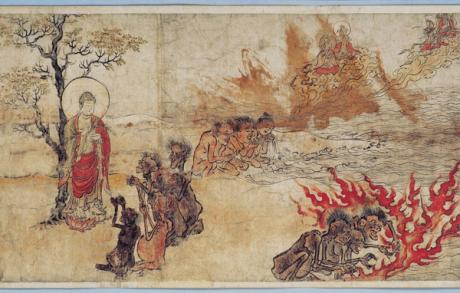The Chair
2012 - Installation (Installation)
Nandan Ghiya
The Chair (2012) foregrounds media-based tensions between analog and digital imaging technologies as a means of challenging the continued circulation of visual ephemera from India’s colonial past. A mix of found photographs and staged studio portraits deliberately made to look older, The Chair features multiple portraits of figures dressed in period costumes that reference the ornate fashions popular during Great Britain’s imperial rule of India. A hybrid frame wraps around this assemblage, a composite of variously ornate and simple wood finishes culled from disused and forgotten pictures. For each portrait, Ghiya obstructs the subject’s face with hand-painted squares resembling pixels, a gesture of willful obfuscation that renders the colonial subject anonymous while also drawing attention to the subtle but inherent violence of image taking. In using elements from both analog and digital photography, The Chair challenges the imagery and stereotypes of colonial India through contemporary digital technology, blurring the line between the historical and the contemporary, the past and the present. But if Ghiya investigates the issue of individuality in recent colonial past times and its successive iterations in a digital world, he also utilizes his practice as a means to reveal how all representation is effectively manipulated. His hand-painted pixels are more than just gestures towards an historical shift from analog to digital – they are marks of a decisive intervention and a reminder that all images are, in effect, produced by multiple layers of construction, artifice, and variant meaning.
Nandan Ghiya is an emerging whose practice explores the disjunction between various forms of image-based media. Although he received no formal training, his mixed media works reveal a savvy understanding of the function that photographs play in defining our perception of cultural and collective narratives. In juxtaposing found studio portraits alongside digitally manipulated images, Ghiya examines how advances in media-based technologies define our contemporary modes of perception while also threatening genealogies of rich indigenous histories. His work could be seen in conversation with artistic traditions of assemblage and collage. His deliberate commitment to handwork with acrylic, however, also suggests a deeper commitment to multidisciplinary practices that don’t entirely refute artistic traditions but instead utilize them to draw out more trenchant conversations about the erasure of cultural identities and modernism’s displacement of a traumatic colonial past.
Colors:
Related works sharing similar palette

© » THEARTNEWSPER
Cities are the heroes in an 'easy-going and unpreachy' publication that takes us on whirlwind tour of art history Art market Museums & heritage Exhibitions Books Podcasts Columns Technology Adventures with Van Gogh Search Search Books review Cities are the heroes in an 'easy-going and unpreachy' publication that takes us on whirlwind tour of art history Fifteen art capitals are captured at their brilliant apogee in Caroline Campbell's book Keith Miller 6 February 2024 Share Detail of Hungry Ghosts Scroll (late 12th century) by an unknown artist Kyoto National Museum The last book I reviewed with this title was by the historian Simon Schama...

© » SLASH PARIS
Camille Esayan, Lara Bouvet — Corps composé(s) — Hôpital européen Georges-Pompidou — Exposition — Slash Paris Connexion Newsletter Twitter Facebook Camille Esayan, Lara Bouvet — Corps composé(s) — Hôpital européen Georges-Pompidou — Exposition — Slash Paris Français English Accueil Événements Artistes Lieux Magazine Vidéos Retour Précédent Suivant Camille Esayan, Lara Bouvet — Corps composé(s) Exposition Collage, photographie, techniques mixtes © Camille Esayan Camille Esayan, Lara Bouvet Corps composé(s) Encore 19 jours : 25 janvier → 1 mars 2024 Un projet de Camille Esayan et Lara Bouvet avec le Service de chirurgie cancérologique, gynécologique et du sein de l’Hôpital européen Georges-Pompidou, Paris...

© » KADIST
Kelly Sinnapah Mary
2021Notebook 10 , l ‘enfance de sanbras (The Childhood of Sanbras) series by Kelly Sinnapah Mary is a sequel to an earlier series by the artist titled Cahier d’un non retour au pays natal (2015)...

© » KADIST
Jessica Warboys
2013The ongoing “Sea Paintings” series is central to the practice of Jessica Warboys...

© » ARTSJOURNAL
‘All my films deal with how to live’: Wim Wenders on Herzog, spirituality and shooting a movie in 16 days | Wim Wenders | The Guardian Skip to main content Skip to navigation Skip to navigation ‘Fast is a gift, fast is unleashed creativity’: Wim Wenders photographed in his Berlin office by Malte Jaeger for the Observer New Review...

© » KADIST
Kota Ezawa
2017The Crime of Art is an animation by Kota Ezawa that appropriates scenes from various popular Hollywood films featuring the theft of artworks: a Monet painting in The Thomas Crown Affair (1999), a Rembrandt in Entrapment (1999), a Cellini in How to Steal a Million (1966), and an emerald encrusted dagger in Topkapi (1964)...

© » SLASH PARIS
Biennale de Lyon — 2024 — Usines Fagor — Exhibition — Slash Paris Login Newsletter Twitter Facebook Biennale de Lyon — 2024 — Usines Fagor — Exhibition — Slash Paris English Français Home Events Artists Venues Magazine Videos Back Biennale de Lyon — 2024 Exhibition Mixed media Upcoming © Biennale de Lyon 2024 Biennale de Lyon 2024 In over 1 year: September 1, 2024 → January 1, 2025 (Dates provisoires) Créée en 1991, la Biennale de Lyon est l’une des plus importantes biennales d’art contemporain au plan international et la première manifestation artistique d’envergure au plan national...













